 |
| Killer Kimchi |
Kimchi. Practically the national dish of Korea, this potent pickle is pungent, sour, spicy and unnecessarily delicious.
It works well as a condiment or side dish, in stews and curries, with rice and noodles, and even in a sandwich or bun - in fact, a kimchi hotdog seems to be de rigueur these days.
Till recently, I've been lazy and got packets or tubs of the stuff from Oriental supermarkets, but I discovered that it's both cheap and easy to make yourself. This is a good thing as I recently had to make a shed-load for my Momofuku tribute dinner Lunchy Peach.
The recipe looks long but I wanted to show you all the steps - it's really straightforward.
 |
| Korean Pepper Flakes and Burmese Shrimp Paste |
And you can tweak the flavours (saltier, sweeter, sourer) so it tastes even better than shop-bought.
(Burmese) shrimp paste, similar to belacan, is my secret ingredient for extra umami - other recipes add chopped-up oysters, dried shrimp or squid, but you could do without and just ramp up the fish sauce.
I've gone for traditional Chinese leaf (aka napa cabbage here), but feel free to free-style and use daikon, cucumber, and even carrots instead ...
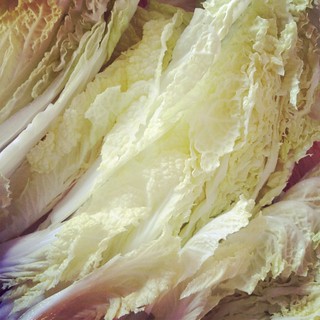 |
| Chinese Leaf |
It will stink out your house, but it's so worth it.
And at this time of year, it's one of the best foods to blast away a cold.
Easy Kimchi Recipe
Makes a massive tub
Ingredients
- Chinese leaf, 3 heads
- 100g salt
- 200g glutinous rice flour
- 200g sugar
- 1 bulb of garlic, peeled
- 2 fat pieces of ginger, both ~ 4 inches long, peeled
- 100g Korean chilli flakes*
- 100ml fish sauce, a good quality one like Three Crabs
- 50g shrimp paste (belacan) - optional
- Bunch of spring onions/scallions
Equipment
- 1 large basin or bowl - enough to take the Chinese leaf
- Tupperware or jars with screw top or clip lids totalling ~ 5 litres capacity.
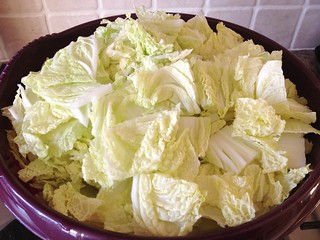 |
| Soak the Chinese leaf |
Wash the Chinese leaf and then cut into chunks about two inch square. Soak in a basin of cold water with the salt for an hour.
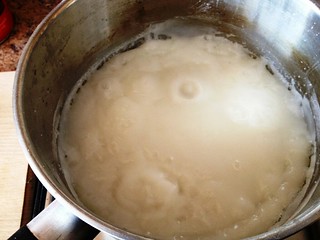 |
| Make the rice paste |
Meanwhile, mix the glutinous rice flour with the sugar and 750ml cold water in a saucepan and then bring to the boil and stir till it bubbles like a cauldron and becomes a translucent paste. Leave to cool.
 |
| Shred the spring onions and ginger |
Shred half the spring onions (both white and green parts) and one piece of ginger into slivers about 2 inches long.
Mince the garlic, the other piece of ginger and the rest of the spring onion (I use a mini chopper).
 |
| Mix the Kimchi marinade ingredients - the brown stuff is the shrimp paste |
Add the minced veg to the cooled rice paste, then whisk in the chilli flakes, fish sauce, and shrimp paste.
Lastly add the shredded spring onions and ginger. This is your kimchi marinade.
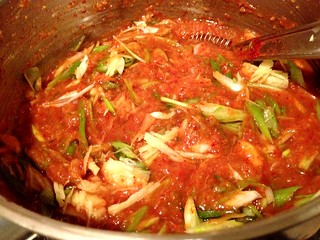 |
| Final kimchi marinade |
Drain and thoroughly rinse the Chinese leaf with cold running water (it will have shrunk down a little) and then squeeze the leaf to get rid of as much moisture as possible.
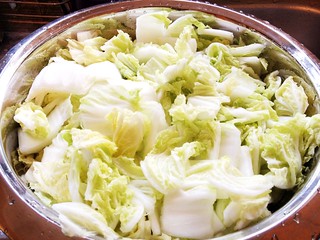 |
| Drain the Chinese leaf |
Then, using the same basin in which you soaked the leaf, mix the Chinese leaf with the kimchi marinade, coating it thoroughly.
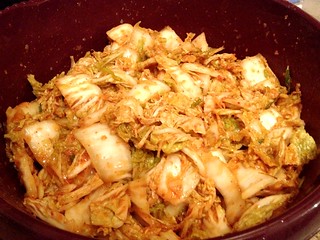 |
| Marinated kimchi ready for packing |
Taste a little and adjust if necessary, eg add more fish sauce or a little sugar, but bear in mind that the flavours will develop and get stronger over time. You can actually eat it straight away, but why would you?
Press down firmly in the Tupperware or jars and seal, making sure you leave a couple of inches of air space above the kimchi - as it ferments, gas will be produced and you really don't want an explosion.
 |
| Tupperware |
Keep at room temperature for about two days (one day in warm weather) and wait for the fermentation to start.
You'll know it's worked when bubbles start to form on the surface and it smells sour, and you may even hear a small hissing noise.
Then store the kimchi in the fridge and let the flavours develop - I think the optimum time is a week to eat "as is", and a fortnight for cooking with.
Eat the kimchi within a month (although you'll probably finish it sooner like I did).
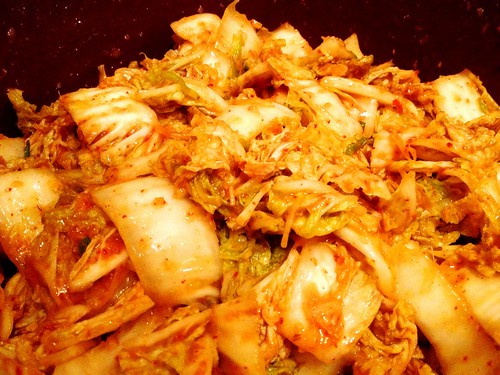 |
| Lovely, lovely kimchi |
*Korean chilli flakes (gochugaru) are also labelled Korean red pepper, red pepper flakes or hot pepper powder in Oriental supermarkets. It's a bright red rather than a rusty colour. Turkish red pepper flakes are a good substitute, but not standard chilli powder or crushed chillies. I got my Korean pepper flakes from Centrepoint Food Store in London, but you can buy them online at Sous Chef.
Comments
And visit the doctor.
@Lizzie Mabbott - I *knew* I remembered someone's actually exploding - brilliant!
Thanks for sharing MiMi!
Hope it went well :)